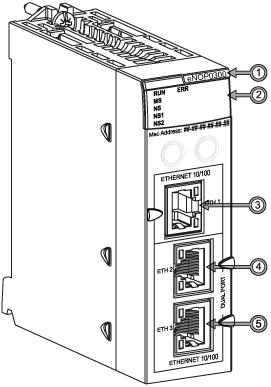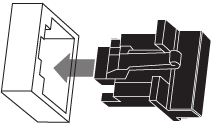The BMENOP0300 module is installed on the local rack of an M580 system. The module provides interfaces for IEC 61850 communication.
The BMENOP0300C (coated) equipment is the ruggedized version of the BMENOP0300 (standard) equipment. It can be used at standard temperatures and in harsh chemical environments.
For more information, refer to chapter Installation in More Severe Environments.
Altitude Operating Conditions
The characteristics apply to the modules BMENOP0300 and BMENOP0300C for use at altitude up to 2000 m (6560 ft). When the modules operate above 2000 m (6560 ft), apply additional derating.
For detailed information, refer to chapter Operating and Storage Conditions.
The main purpose of the BMENOP0300 module is to provide connection with IEC 61850 devices as well as device management software that utilizes the IEC 61850 standard.
The BMENOP0300 module is mounted on the local rack and supports communication as:
The BMENOP0300 module also provides high network availability by supporting:
-
RSTP protocol
-
IP forwarding capability
-
M580 redundant functionality
-
SNTP, SNMP, and Syslog
-
Data modeling in IED configurator and DDDT representation in Control Expert
-
Dual-bus backplane (X Bus and Ethernet)
-
Cyber security
The maximum number of BMENOP0300 modules that can be mounted on a local rack is determined by your choice of CPU. The maximum numbers of communication modules, including BMENOP0300 modules, supported by M580 CPUs are as follows:
|
CPU
|
Maximum Number of Communication Modules
|
|
BMEP581020
|
2
|
|
BME•5820•0
|
2
|
|
BMEP5830•0
|
3
|
|
BME•5840•0
|
4
|
|
BMEP585040
|
4
|
|
BME•586040
|
4
|
BMENOP0300:
1
commercial reference (module name)
2
LED display
3
Ethernet port (ETH 1)
4
Ethernet port (ETH 2)
5
Ethernet port (ETH 3)
NOTE: To help prevent dust from entering the unused Ethernet ports on this module, cover the port with the stopper:
The BMENOP0300 module has three external Ethernet ports, whose IP addresses can be configured in the Communication Settings → IP Setting tab.
|
Port
|
Description
|
|
ETH 1
|
The ETH 1 port allows the diagnosis of Ethernet ports and provides access to external tools and devices (Control Expert, ConneXium Network Manager, HMI, etc.). The port supports these modes:
-
port mirroring: In this mode, you can connect to a PC and use packet sniffing software to analyze the traffic traveling through one or more of the other module ports.
-
access port (default): In this mode, you can connect an Ethernet device (for example, HMI, PC with Control Expert installed, PC with ConneXium Network Manager tool) to communicate the PLC/CPU, the BMENOP0300 module, or other devices connected to the M580 network.
-
extended network: In this mode, you can connect the ETH 1 port to another existing DIO network that you wish to communicate with your M580 EIO network.
NOTE: In port mirroring mode, the ETH 1 port acts like a read-only port. You cannot access devices (ping, connect to Control Expert, etc.) through the ETH_1 port.
|
|
Backplane
|
The Backplane port, located on the back of the module, allows you to connect to an Ethernet backplane The port supports this mode:
-
access port (default): In this mode, you can connect an Ethernet device (for example, HMI, PC with Control Expert installed, PC with ConneXium Network Manager tool) to communicate the PLC/CPU, the BMENOP0300 module, or other devices connected to the M580 network.
|
|
ETH 2 and ETH 3
|
These 2 copper ports provide:
-
connections for Ethernet services
-
star, loop, or mesh topology
-
support for RSTP
NOTE: Only ETH 2 and ETH 3 ports support RSTP.
|

